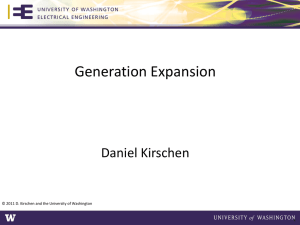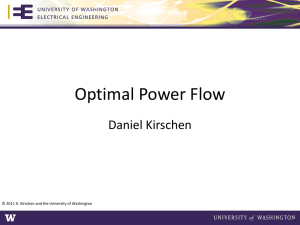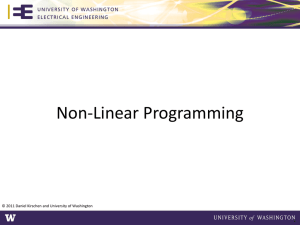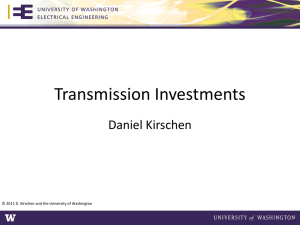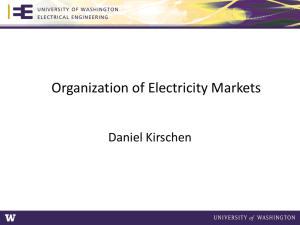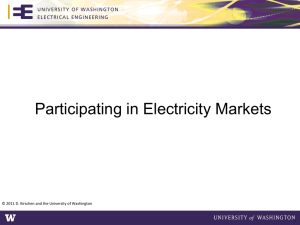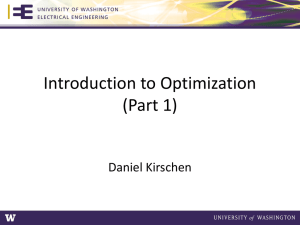Optimization - University of Washington
advertisement
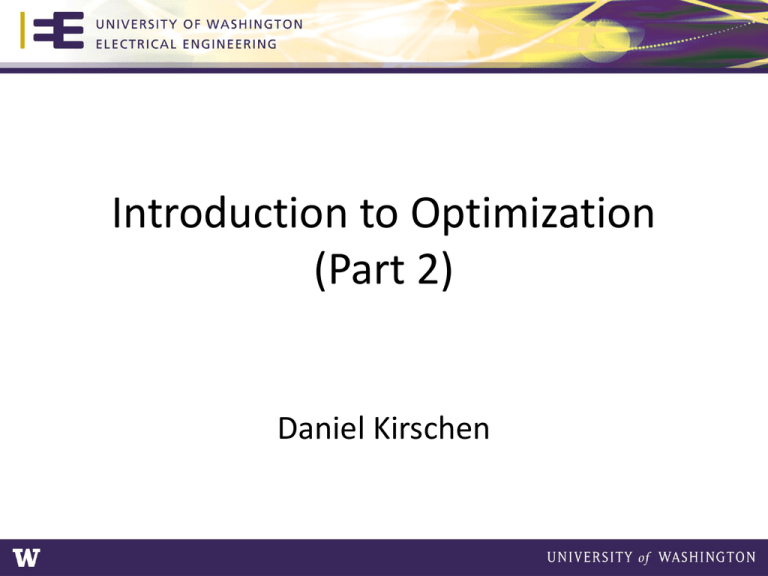
Introduction to Optimization (Part 2) Daniel Kirschen Optimization with inequality constraints Minimise f ( x1 , x2 ,.. , xn ) Objective function subject to: w 1 ( x1 , x2 ,.. , xn ) = 0 Equality constraints w m ( x1 , x2 ,.. , xn ) = 0 and: g1 ( x1 , x2 ,.. , xn ) £ 0 Inequality constraints gp ( x1 , x2 ,.. , xn ) £ 0 © 2011 D. Kirschen and University of Washington 2 Example: Economic Dispatch x1 x2 G1 G2 x 1min £ x 1 £ x 1max L x 2min £ x 2 £ x 2max Minimise C = a1 + b1 x 12 + a 2 + b 2 x 22 Subject to: x1 + x 2 = L Equality constraints x 1 - x 1max £ 0 x 1min - x 1 £ 0 x2 - x max 2 £0 x 2min - x 2 £ 0 © 2011 D. Kirschen and University of Washington Inequality constraints 3 Example: Economic Dispatch Minimise C = a1 + b1 x 12 + a 2 + b 2 x 22 x2 x1 + x 2 = L Family of ellipses Ellipse tangent to equality constraint at A Inequality constraints are satisfied x2max A x2min x1 min © 2011 D. Kirschen and University of Washington x1max x1 4 Example: Economic Dispatch What is the solution for a larger load? Ellipse tangent to equality constraint at B Inequality constraints are NOT satisfied! x2 x 1 + x 2 = L' x1 + x 2 = L x2max A B x2min x1min © 2011 D. Kirschen and University of Washington x1max x1 5 Example: Economic Dispatch C is the solution because it is the point on the equality constraint that satisfies the inequality constraints at minimum cost x2 x 1 + x 2 = L' x1 + x 2 = L x2max C A B x2min x1min © 2011 D. Kirschen and University of Washington x1max x1 6 Binding Inequality Constraints • A binding inequality constraint is an inequality constraint that is satisfied exactly • Example: – If we must have x1 ≤ x1max – And at the solution we have x1 = x1max – Then the constraint x1 ≤ x1max is said to be binding • ALL of the inequality constraints must be satisfied • Only a FEW will be binding (or active) at any given time • But we don’t know ahead of time which inequality constraints will be binding! • All equality constraints are always binding © 2011 D. Kirschen and University of Washington 7 Solution using Lagrange multipliers Minimise f ( x1 , x2 ,.. , xn ) subject to: w i ( x1 , x2 ,.. , xn ) = 0 g j ( x1 , x2 ,.. , xn ) £ 0 i = 1,...m j = 1,...p Lagrangian function: ( x1,.. , xn , l1,..., lm , m1,..., m p ) = f ( x1,… , xn ) m + å liw i ( x1 ,.. , xn ) i=1 p + å m j g j ( x1 ,.. , xn ) j=1 © 2011 D. Kirschen and University of Washington 8 Optimality Conditions (Known as the Karush Kuhn Tucker or KKT conditions) m p i=1 j =1 ( x ,l ,m ) = f ( x ) + å l i w i ( x ) + å m j g j ( x ) ¶g j ( x ) ¶ ( x, l, m ) ¶f ( x ) m ¶w k ( x ) p º + å lk + å mj =0 ¶xi ¶xi ¶xi ¶xi k=1 j=1 i = 1,...n ¶ ( x, l, m ) º w k ( x) = 0 ¶lk k = 1,...m ¶ ( x, l, m ) º gj ( x) £ 0 ¶m j j = 1,... p m j gj ( x) = 0 j = 1,... p mj ³ 0 Complementary Slackness Conditions © 2011 D. Kirschen and University of Washington j = 1,... p 9 Complementary slackness conditions m j g j ( x) = 0 mj ³0 Two possibilities for each constraint j: m j = 0 then the constraint g j ( x ) is non - binding Þ g j ( x ) < 0 OR g j ( x ) = 0 then the constraint g j ( x ) is binding Þ m j > 0 © 2011 D. Kirschen and University of Washington 10 Solving the problem • The KKT conditions are not quite enough to solve the problem • The complementary slackness conditions: – Tell us that an inequality constraint is either binding or non-binding – DON’T tell us which constraints are binding and non-binding • The binding constraints have to be identified through trial and error © 2011 D. Kirschen and University of Washington 11 Example Minimise f ( x 1 , x 2 ) = 0.25 x + x 2 1 2 2 Subject to: w ( x1 ,x 2 ) º 5 - x1 - x 2 = 0 g ( x 1 , x 2 ) º x 1 + 0.2 x 2 - 3 £ 0 © 2011 D. Kirschen and University of Washington 12 Example x2 g ( x 1 , x 2 ) º x 1 + 0.2 x 2 - 3 £ 0 f ( x 1 , x 2 ) = 0.25 x 12 + x 22 x1 © 2011 D. Kirschen and University of Washington w ( x1 , x 2 ) º 5 - x1 - x 2 = 0 13 Example ( x 1 , x 2 , l , m ) = f ( x 1 , x 2 ) + lw ( x 1 , x 2 ) + mg ( x 1 , x 2 ) = 0.25 x 12 + x 22 + l ( 5 - x 1 - x 2 ) + m ( x 1 + 0.2 x 2 - 3 ) ¶ º 0.5x1 - l + m = 0 ¶x1 ¶ º 2x2 - l + 0.2 m = 0 ¶x2 ¶ º 5 - x1 - x2 = 0 ¶l ¶ º x1 + 0.2x2 - 3 £ 0 ¶m m g(x) º m ( x1 + 0.2x2 - 3) = 0 and m ³ 0 © 2011 D. Kirschen and University of Washington 14 Example KKT conditions do not tell us if inequality constraint is binding Must use a trial and error approach Trial 1: Assume inequality constraint is not binding μ = 0 From solution of example without inequality constraint, we know that the solution is then: x1 = 4; x2 = 1 Inserting these values in the inequality constraint, we get: x1 + 0.2x2 - 3 = 1.2 ³ 0 This solution is thus not an acceptable solution © 2011 D. Kirschen and University of Washington 15 Example Trial 2: Assume that the inequality constraint is binding ¶ º 5 - x1 - x 2 = 0 ¶l ¶ º x 1 + 0.2 x 2 - 3 = 0 ¶m ¶ º 0.5 x 1 - l + m = 0 ¶x 1 ¶ º 2 x 2 - l + 0.2 m = 0 ¶x 2 x 1 = 2.5 x 2 = 2.5 l = 5.9375 m = 4.6875 All KKT conditions are satisfied. This solution is acceptable © 2011 D. Kirschen and University of Washington 16 Example: graphical solution x2 g ( x 1 , x 2 ) º x 1 + 0.2 x 2 - 3 £ 0 Solution of problem with inequality constraint f ( x 1 , x 2 ) = 0.25 x + x 2 1 Solution of problem without constraints © 2011 D. Kirschen and University of Washington 2 2 Solution of problem without inequality constraint x1 w ( x1 , x 2 ) º 5 - x1 - x 2 = 0 17 Application to Economic Dispatch x1 G1 x2 G2 L minimise f ( x 1 , x 2 ) = C 1 ( x 1 ) + C 2 ( x 2 ) s.t . w ( x 1 , x 2 ) º L - x 1 - x 2 = 0 x 1min £ x 1 £ x 1max x 2min £ x 2 £ x 2max © 2011 D. Kirschen and University of Washington g1 ( x 1 , x 2 ) º x 1 - x 1max £ 0 g 2 ( x 1 , x 2 ) º x 1min - x 1 £ 0 g 3 ( x 1 , x 2 ) º x 2 - x 2max £ 0 g 4 ( x 1 , x 2 ) º x 2min - x 2 £ 0 18 Application to Economic Dispatch ( x 1 , x 2 ,l ,m 1 ,m 2 ,m 3 ,m 4 ) = C1 ( x 1 ) + C 2 ( x 2 ) + l ( L - x 1 - x 2 ) + m 1 ( x 1 - x 1max ) + m 2 ( x 1min - x 1 ) + m 3 ( x 2 - x 2max ) + m 4 ( x 2min - x 2 ) KKT Conditions: dC 1 ¶ º - l + m1 - m 2 = 0 ¶x 1 dx 1 dC 2 ¶ º -l +m3 -m4 = 0 ¶x 2 dx 2 ¶ º L - x1 - x 2 = 0 ¶l © 2011 D. Kirschen and University of Washington 19 Application to Economic Dispatch KKT Conditions (continued): ¶ º x 1 - x 1max £ 0 ¶m 1 m 1 ( x 1 - x 1max ) = 0 ; m 1 ³ 0 ¶ º x 1min - x 1 £ 0 ¶m 2 m 2 ( x 1min - x 1 ) = 0 ; m 2 ³ 0 ¶ º x 2 - x 2max £ 0 ¶m 3 m 3 ( x 2 - x 2max ) = 0 ; m 3 ³ 0 ¶ º x 2min - x 2 £ 0 ¶m 4 m 4 ( x 2min - x 2 ) = 0 ; m 4 ³ 0 © 2011 D. Kirschen and University of Washington 20 “Solving” these equations Trial #1: No generator is at a limit No inequality constraint is binding and all μ’s are equal to zero dC 1 ¶ º -l =0 ¶x 1 dx 1 dC 2 ¶ º -l =0 ¶x 2 dx 2 dC 1 dx 1 = dC 2 dx 2 =l ¶ º L - x1 - x 2 = 0 ¶l All generators operate at the same incremental cost © 2011 D. Kirschen and University of Washington 21 Solving the KKT Equations Trial #2: Generator 1 is at its upper limit; Other limits not binding x1 - x1max = 0 Þ m1 ³ 0; m2 = m3 = m4 = 0 dC 1 ¶ º - l + m1 = 0 ¶x 1 dx 1 dC 1 dC 2 ¶ º -l =0 ¶x 2 dx 2 dC 2 dx 1 dx 2 = l - m1 £ l =l All generators do NOT operate at the same incremental cost! The incremental cost of unit 1 is lower…. Why? If that was possible, more power would be produced by unit 1 © 2011 D. Kirschen and University of Washington 22 Solving the KKT Equations Trial #3: Generator 1 is at its lower limit; other limits not binding x1min - x1 = 0 Þ m2 ³ 0; m1 = m3 = m4 = 0 dC 1 ¶ º -l -m2 = 0 ¶x 1 dx 1 dC 1 dC 2 ¶ º -l =0 ¶x 2 dx 2 dC 2 dx 1 dx 2 = l + m2 ³ l =l Again, all generators do NOT operate at the same incremental cost! The incremental cost of unit 1 is higher… Why? If that was possible, less power would be produced by unit 1 © 2011 D. Kirschen and University of Washington 23 Physical interpretation of the Lagrangian Minimise f (x) subject to: g ( x ) = K or K - g ( x ) = 0 Where g ( x ) is either an equality constraint or a binding inequality constraint Lagrangian: ( x, l ) = f (x) + l éë K - g ( x ) ùû The optimum values of the decision variables and the Lagrange multipliers are given by the optimality conditions: ¶ ¶f ¶g º -l =0 ¶x ¶x ¶x ¶ º K - g( x) = 0 ¶l © 2011 D. Kirschen and University of Washington x ,l * * 24 What happens when I move the constraint? Equality constraint: g(x) = K + DK Inequality constraint: g(x) ³ K + DK Keep DK sufficiently small that an optimal solution still exists and involves the same binding inequality constraints The optimal value of the decision variables and of the Lagrange multipliers change as DK changes: x * = x(K ) l * = l (K ) © 2011 D. Kirschen and University of Washington 25 What happens when I move the constraint? Lagrangian: ( x, l ) = f (x) + l éë K - g ( x ) ùû d df dx dg dx dl = +l-l + K - g(x)] [ dK dx dK dx dK dK Re-arranging the terms, we get d dg ù dx d l é df =l+ê -l ú + K - g(x)] [ dK dx û dK dK ë dx At the optimum: =0 =0 d dK © 2011 D. Kirschen and University of Washington =l * opt 26 Physical interpretation of the Lagrangian At the optimum: ( ) ( ) x* , l * = f (x * ) + l * éë K - g x* ùû Complementary slackness =0 The value of the Lagrangian function is thus equal to the value of the cost or objective function at the optimum d dK =l opt * The value of the Lagrange multipliers at the optimal solution thus tell us by how much the the objective changes when the constraints change The Lagrange multipliers are the marginal cost of the constraints © 2011 D. Kirschen and University of Washington 27 Physical Interpretation of Lagrange Multipliers • The Lagrange multipliers are thus often called shadow costs • Non-binding inequality constraints have a zero marginal cost • Adding binding constraints always increases the cost of a solution • Tightening a constraint increases the cost • Relaxing a constraint decreases the cost © 2011 D. Kirschen and University of Washington 28 Physical Interpretation of Lagrange Multipliers • Note that these observations are valid only for sufficiently small changes in the constraints • If the constraints change substantially, the set of constraints that is binding at the optimum may change • The constraints that are no longer binding would then have a zero marginal cost • The newly binding constraints would then have a non-zero marginal cost © 2011 D. Kirschen and University of Washington 29 Example: Economic Dispatch Using Lagrange Multipliers Example: Economic Dispatch A load L = 800 MW is supplied by three generating units. The cost characteristics of these generating units are given by the following expressions: C1 = 100 + 8 P1 + 0.1 P12 [$/h] 230 ≤ P1 ≤ 400 MW C2 = 200 + 7 P2 + 0.06 P22 [$/h] 100 ≤ P2 ≤ 500 MW C3 = 250 + 9 P3 + 0.07 P32 [$/h] 100 ≤ P3 ≤ 260 MW Calculate the optimal economic dispatch. © 2011 D. Kirschen & University of Washington 31 Example: Form the Lagrangian = 100 + 8P1 + 0.1P 2 1 +200 + 7P2 + 0.06P 2 2 +250 + 9P3 + 0.07P 2 3 + l (L - P1 - P2 - P3 ) + m1 (P1 - 400) + m2 (230 - P1 ) + m3 (P2 - 500) + m4 (100 - P2 ) + m5 (P3 - 260) + m6 (100 - P3 ) © 2011 D. Kirschen & University of Washington 32 Example: Optimality Conditions Set the partial derivatives of the Lagrangian with respect to the decision variables and λ to zero: ¶ º 8 + 0.2P1 - l + m1 - m2 = 0 ¶P1 ¶ º 7 + 0.12P2 - l + m 3 - m 4 = 0 ¶P2 ¶ º 9 + 0.14P3 - l + m5 - m6 = 0 ¶P3 ¶ º L - P1 - P2 - P3 = 0 ¶l © 2011 D. Kirschen & University of Washington (1) (2) (3) (4) 33 Example: Optimality Conditions Set the partial derivatives of the Lagrangian with respect to the μ’s to zero: ¶ º P1 - 400 £ 0 ¶ m1 ¶ º 230 - P1 £ 0 ¶ m2 ¶ º P2 - 500 £ 0 ¶ m3 © 2011 D. Kirschen & University of Washington 34 Example: Optimality Conditions Set the partial derivatives of the Lagrangian with respect to the μ’s to zero: ¶ º 100 - P2 £ 0 ¶m4 ¶ º P3 - 260 £ 0 ¶ m5 ¶ º 100 - P3 £ 0 ¶ m6 © 2011 D. Kirschen & University of Washington 35 Example: Complementary slackness m1.(P1 - 400) = 0; m1 ³ 0 m2 .(230 - P1 ) = 0; m2 ³ 0 m3 .(P2 - 500) = 0; m3 ³ 0 m4 .(100 - P2 ) = 0; m4 ³ 0 m5 .(P3 - 260) = 0; m5 ³ 0 m6 .(100 - P3 ) = 0; m6 ³ 0 © 2011 D. Kirschen & University of Washington 36 Example: First Trial (1) Assume that none of the inequality constraints is binding This means that all the μ‘s are zero Set the μ’s equal to zero in the optimality conditions. Equations (1) to (3) become: ¶ º 8 + 0.2P1 - l = 0 ¶P1 ¶ º 7 + 0.12P2 - l = 0 ¶P2 ¶ º 9 + 0.14P3 - l = 0 ¶P3 © 2011 D. Kirschen & University of Washington Þ P1 = Þ P2 = Þ P3 = l-8 0.2 l-7 0.12 l-9 0.14 37 Example: First Trial (2) Inserting these expressions in Equation (4), we get: L - 5(l - 8) - 8.33(l - 7) - 7.14(l - 9) = 0 l = 46.96 $/MWh With L = 800MW, we get: Replacing λ in the equations on the previous slide, we have: P1 = 194.8 MW <P min 1 = 230 MW Not a valid solution trial fails P2 = 333.0 MW P3 = 271.2 MW © 2011 D. Kirschen & University of Washington >P max 3 = 260 MW 38 Example: Second Trial (1) We must try another combination of binding constraints. 6 inequality constraints 26 = 64 possible combinations Realistic system ridiculously large number of combinations Must use information from previous trials Let us try: P1 = P1min = 230 MW P3 = P max 3 = 260 MW Þ m2 ¹ 0 Þ m5 ¹ 0 m1 = m3 = m4 = m6 = 0 © 2011 D. Kirschen & University of Washington 39 Example: Second Trial (2) L - P1 - P2 - P3 = 0 P1 = P1min = 230 MW P3 = P max 3 Þ P2 = 310 MW = 260 MW However, we must check that the μ‘s meet the complementary slackness conditions © 2011 D. Kirschen & University of Washington 40 Example: Second Trial (3) m1 = m3 = m4 = m6 = 0 ¶ º 8 + 0.2P1 - l - m2 = 0 ¶P1 Þ m2 = 9.8 $/MWh ¶ º 7 + 0.12P2 - l = 0 ¶P2 Þ l = 44.2 $/MWh ¶ º 9 + 0.14P3 - l + m5 = 0 Þ m5 = -1.2 $/MWh ¶P3 £ 0! © 2011 D. Kirschen & University of Washington 41 Example: Second Trial (4) The constraint P3 £ P max 3 should not be binding! What is happening? First trial: P1 P1 P max 1 P min 1 P2 P2max P2min P3 P min 3 © 2011 D. Kirschen & University of Washington P max 3 P2 P3 42 Example: Second Trial (5) In the second trial, we “pushed” P1 towards its lower limit and P3 towards its upper limit. However, there was no need to push P3 because increasing P1 would naturally reduce P3 below its limit. Second trial: P1 P1 P max 1 P min 1 P2 P2max P2min P3 P min 3 © 2011 D. Kirschen & University of Washington P max 3 P2 P3 43 Example: Third Trial (1) P1 = P1min = 230 MW Þ m2 ¹ 0 m1 = m3 = m4 = m5 = m6 = 0 ¶ º 7 + 0.12P2 - l = 0 ¶P2 ¶ º 9 + 0.14P3 - l = 0 ¶P3 ¶ º L - P1 - P2 - P3 = 0 ¶l © 2011 D. Kirschen & University of Washington l = 44.75 $/MWh P2 = 315 MW P3 = 255 MW 44 Example: Third Trial (2) ¶ º 8 + 0.2P1 - l - m2 = 0 Þ m2 = 9.25 $/MWh ¶P1 Solution that satisfies all the optimality conditions: P1 = 230 MW P2 = 315 MW P3 = 255 MW l = 44.75 $/MWh Cost of an extra MW of load m2 = 9.25 $/MWh Value of reducing P1min by 1MW © 2011 D. Kirschen & University of Washington 45 Example: Optimal Solution Third trial: P1 P1 P max 1 P min 1 P2 P2max P2min P3 P min 3 © 2011 D. Kirschen & University of Washington P max 3 P2 P3 46 Practical Economic Dispatch Equal Incremental Cost Dispatch dC A dC B dC C dPA dPB dPC l PA PB PC + PA + PB + PC © 2011 D. Kirschen and University of Washington 48 Lambda search algorithm 1. Choose a starting value for l 2. Calculate PA ,PB ,PC such that dC A (PA ) dC B (PB ) dCC (PC ) = = =l dPA dPB dPC 3. If one of these values exceeds its lower or upper limit, fix it at that limit 4. Calculate PTOTAL = PA + PB + PC 5. If PTOTAL < L, then increase l Else If PTOTAL > L, then decrease l Else If PTOTAL » L, then exit 6. Go To Step 2 © 2011 D. Kirschen and University of Washington 49 Linear Cost Curves CA CB PA PB PAMAX PBMAX dC A dC B dPA dPB l PA PAMAX © 2011 D. Kirschen and University of Washington PB PBMAX 50 Linear Cost Curves CA CB PA PB PAMAX PBMAX dC A dC B dPA dPB l PA PAMAX © 2011 D. Kirschen and University of Washington PB PBMAX 51 Linear Cost Curves CA CB PA PB PAMAX PBMAX dC A dC B dPA dPB l PA PAMAX © 2011 D. Kirschen and University of Washington PB PBMAX 52 Linear Cost Curves • The output of the unit with the lowest incremental cost (in this case unit A) is increased first (it is “loaded” first) • The output of the other units is not increased until unit A is loaded up to its maximum • The output of the unit with second lowest incremental cost is then increased (i.e. the “second cheapest” unit) • And so on until the generation meets the load © 2011 D. Kirschen and University of Washington 53 Linear cost curves with minimum generation CA CB PA PAMIN PB PAMAX PBMIN dC A dC B dPA dPB PBMAX PA PAMIN © 2011 D. Kirschen and University of Washington PAMAX PB PBMIN PBMAX 54 Linear cost curves with minimum generation • All generating units are first loaded up to their minimum generation • The generating units are then loaded in order of incremental cost © 2011 D. Kirschen and University of Washington 55 Piecewise Linear Cost Curves CA CB PA PB dC A dC B dPA dPB PA © 2011 D. Kirschen and University of Washington PB 56 Economic Dispatch with Piecewise Linear Cost Curves CA CB PA PB dC A dC B dPA dPB l PA © 2011 D. Kirschen and University of Washington PB 57 Economic Dispatch with Piecewise Linear Cost Curves CA CB PA PB dC A dC B dPA dPB l PA © 2011 D. Kirschen and University of Washington PB 58 Economic Dispatch with Piecewise Linear Cost Curves CA CB PA PB dC A dC B dPA dPB l PA © 2011 D. Kirschen and University of Washington PB 59 Economic Dispatch with Piecewise Linear Cost Curves CA CB PA PB dC A dC B dPA dPB l PA © 2011 D. Kirschen and University of Washington PB 60 Economic Dispatch with Piecewise Linear Cost Curves CA CB PA PB dC A dC B dPA dPB l PA © 2011 D. Kirschen and University of Washington PB 61 Economic Dispatch with Piecewise Linear Cost Curves • All generators except one are at breakpoints of their cost curve • The marginal generator is between breakpoints to balance the load and generation • Not well-suited for lambda-search algorithm • Very fast table lookup algorithm: – Rank all the segments of the piecewise linear cost curves in order of incremental cost – First dispatch all the units at their minimum generation – Then go down the table until the generation matches the load © 2011 D. Kirschen and University of Washington 62 Example dC A dPA 0.7 0.5 0.3 30 80 120 150 PA dC B Unit PSegment Ptotal Lambda A&B min 20+30 = 50 50 B 70-20=50 100 0.1 A 80-30=50 150 0.3 A 120-80=40 190 0.5 B 110-70=40 230 0.6 A 150-120=30 260 0.7 B 140-110=30 290 0.8 dPB If Pload = 210MW 0.8 0.6 0.1 20 70 © 2011 D. Kirschen and University of Washington 110 140 PB The optimal economic dispatch is: PA = 120MW PB = 90 MW λ = 0.6 63
